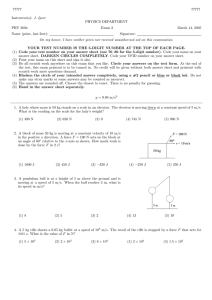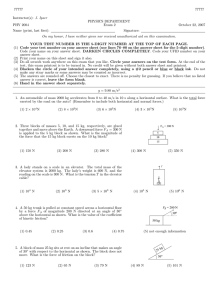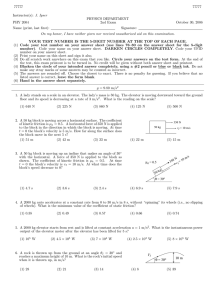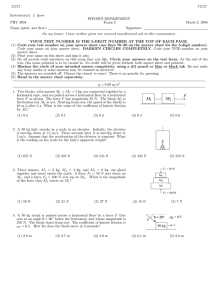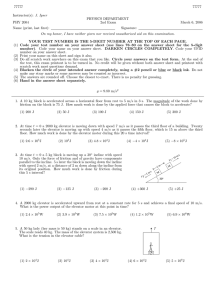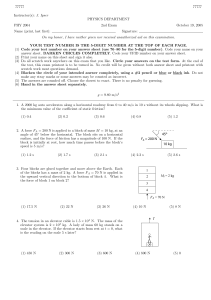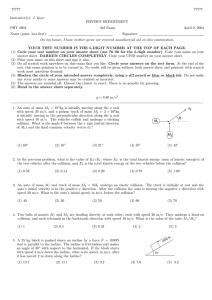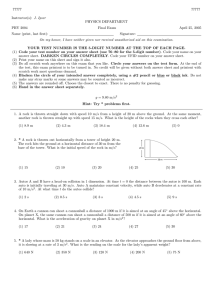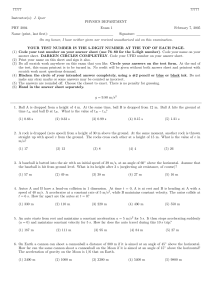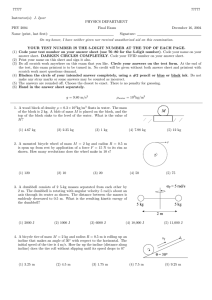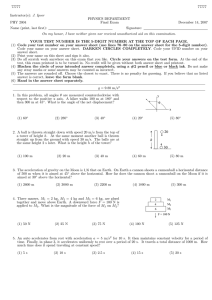77777 J. Ipser PHYSICS DEPARTMENT PHY 2004
advertisement
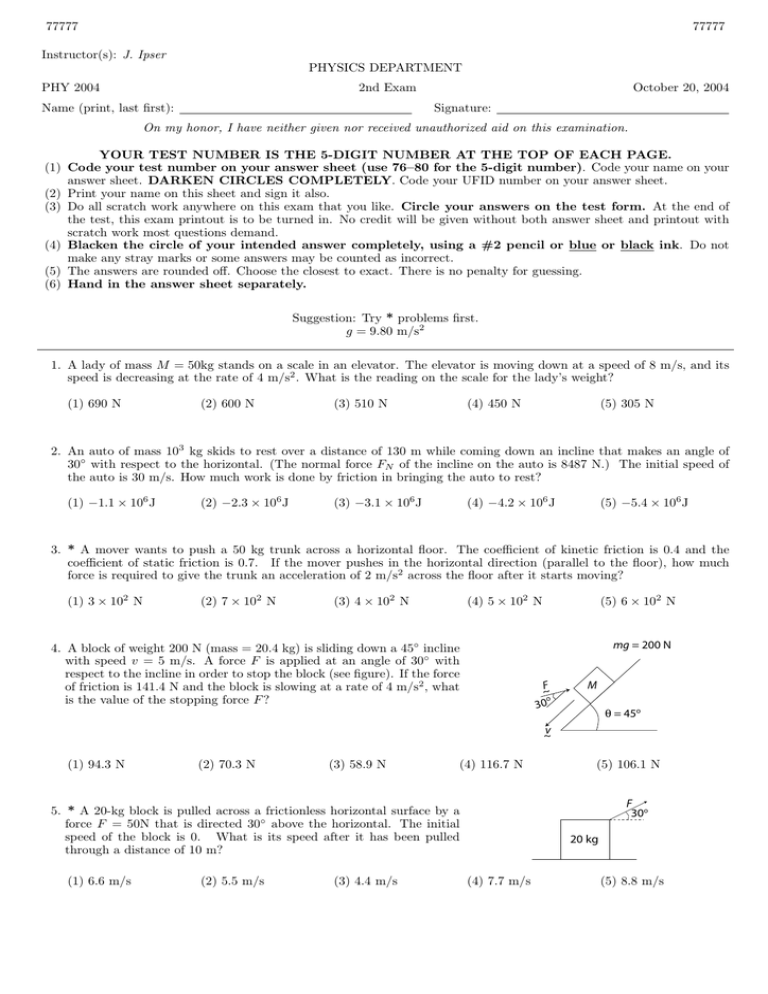
77777 77777 Instructor(s): J. Ipser PHYSICS DEPARTMENT PHY 2004 2nd Exam Name (print, last first): October 20, 2004 Signature: On my honor, I have neither given nor received unauthorized aid on this examination. YOUR TEST NUMBER IS THE 5-DIGIT NUMBER AT THE TOP OF EACH PAGE. (1) Code your test number on your answer sheet (use 76–80 for the 5-digit number). Code your name on your answer sheet. DARKEN CIRCLES COMPLETELY. Code your UFID number on your answer sheet. (2) Print your name on this sheet and sign it also. (3) Do all scratch work anywhere on this exam that you like. Circle your answers on the test form. At the end of the test, this exam printout is to be turned in. No credit will be given without both answer sheet and printout with scratch work most questions demand. (4) Blacken the circle of your intended answer completely, using a #2 pencil or blue or black ink. Do not make any stray marks or some answers may be counted as incorrect. (5) The answers are rounded off. Choose the closest to exact. There is no penalty for guessing. (6) Hand in the answer sheet separately. Suggestion: Try * problems first. g = 9.80 m/s2 1. A lady of mass M = 50kg stands on a scale in an elevator. The elevator is moving down at a speed of 8 m/s, and its speed is decreasing at the rate of 4 m/s2 . What is the reading on the scale for the lady’s weight? (1) 690 N (2) 600 N (3) 510 N (4) 450 N (5) 305 N 2. An auto of mass 103 kg skids to rest over a distance of 130 m while coming down an incline that makes an angle of 30◦ with respect to the horizontal. (The normal force FN of the incline on the auto is 8487 N.) The initial speed of the auto is 30 m/s. How much work is done by friction in bringing the auto to rest? (1) −1.1 × 106 J (2) −2.3 × 106 J (3) −3.1 × 106 J (4) −4.2 × 106 J (5) −5.4 × 106 J 3. * A mover wants to push a 50 kg trunk across a horizontal floor. The coefficient of kinetic friction is 0.4 and the coefficient of static friction is 0.7. If the mover pushes in the horizontal direction (parallel to the floor), how much force is required to give the trunk an acceleration of 2 m/s2 across the floor after it starts moving? (1) 3 × 102 N (2) 7 × 102 N (3) 4 × 102 N (4) 5 × 102 N 4. A block of weight 200 N (mass = 20.4 kg) is sliding down a 45◦ incline with speed v = 5 m/s. A force F is applied at an angle of 30◦ with respect to the incline in order to stop the block (see figure). If the force of friction is 141.4 N and the block is slowing at a rate of 4 m/s2 , what is the value of the stopping force F ? (5) 6 × 102 N mg = 200 N F ~ o 0 3 M θ = 45o v ~ (1) 94.3 N (2) 70.3 N (3) 58.9 N (4) 116.7 N F 30o 5. * A 20-kg block is pulled across a frictionless horizontal surface by a force F = 50N that is directed 30◦ above the horizontal. The initial speed of the block is 0. What is its speed after it has been pulled through a distance of 10 m? (1) 6.6 m/s (2) 5.5 m/s (3) 4.4 m/s (5) 106.1 N 20 kg (4) 7.7 m/s (5) 8.8 m/s 77777 77777 6. An elevator of mass 103 kg is lifted from rest to a height of 20 m and is then lowered to a height of 10 m, at which point its speed is 4 m/s. How much work is done by the elevator motor during this process? (Hint: Use the work-energy theorem.) (1) 105 J (2) 104 J (3) 106 J (4) 107 J (1) 14 (2) 19 (3) 23 10 0 m /s 7. * A ball of mass 0.2 kg is initially moving in the negative x direction at 50 m/s. It is struck by a bat, and immediately after the impact is moving up with speed 100 m/s at an angle of 45◦ relative to the positive x direction. What is the vertical component of the bat’s impulse on the ball, in kg m/s? (5) 108 J * (4) 29 45o 50 m/s (5) 34 8. Autos A and B undergo a one-dimensional collision. The weight of A is twice that of B. Auto B is initially at rest. Immediately after the collision, auto B is moving at 10 m/s. What is the decrease in auto A’s speed in the collision? (1) 5 m/s (2) 0 (3) 2.5 m/s (4) 7.5 m/s (5) 10 m/s
